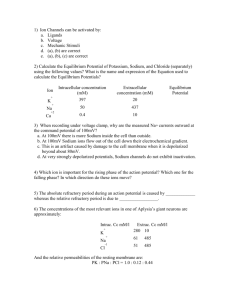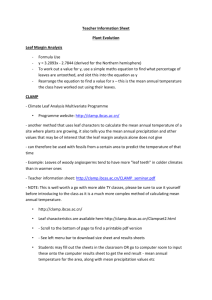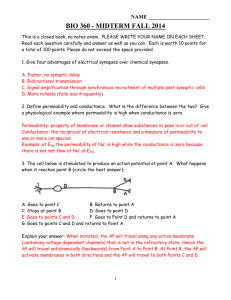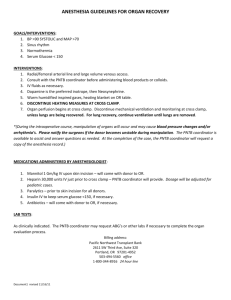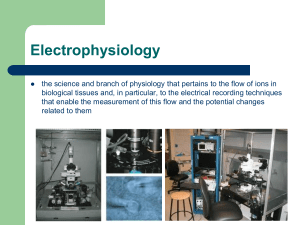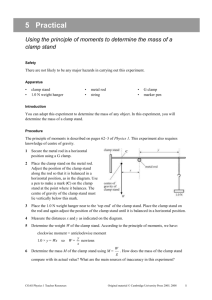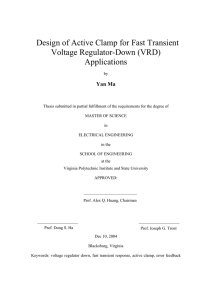Class ppt.
advertisement
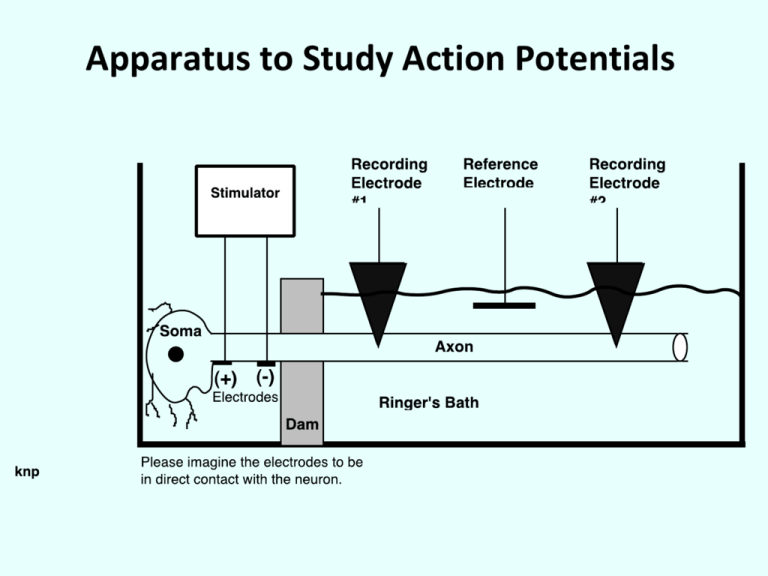
Apparatus to Study Action Potentials Stimulus and Response Membrane Model The dc generator is very low capacity. What does this means (structurally)? Membrane Components Action Potentials Active Responses APs at Above Threshold Stimuli Graded vs. Action Potentials The Events of an Action Potential Membrane Model #2 This model is valid ONLY for a very thin section of the length of an axon (or muscle fiber). This sort of model was hypothesized by the late 1940s The Voltage Clamp, part 1 In order for Em to change, the total charge (Q) across the membrane capacitance (Cm) must change. For Q to change, a current must flow. (Obviously!) However, any current associated with the membrane has two components: • one associated with charging or discharging the Cm (called iC) • another, iR, associated with current flow through the various parallel membrane resistances, lumped together as RM. • Thus: iM = iC + iR The Voltage Clamp, part 2 We can only measure TOTAL membrane current, im directly. But, we are most interested in the "resistive" current components because these are associated with ionic movements through channels and gates. -- Is there a way to separate ir from the capacitive current, iC? The Voltage Clamp, part 3 Recall that: QC = EC * CM = VC * CM If we take the time derivative of the last equation (to get current flowing in or out of the capacitance, ic): dQc dVc = CM dt dt dVc iC = C M dt The Voltage Clamp, part 4 If we substitute the expression for iC (last slide) into the total membrane current equation, we get: dV im = iR + CM dT Reminder: total membrane current, im, is: im = iR + iC If there is some way to keep the transmembrane potential (Em) constant (dV/dt=0) then: m R i =i Thus, if EM is constant, then any current we measures is moving through the membrane resistance(s) –i.e., these currents are due to specific ions moving through specific types of channels. How can we keep Em constant during a time (the AP) when Em normally changes rapidly? Answer: we use a device called the voltage clamp to deliver a current to the inside of the cell -- initially to change Em to some new “clamped” voltage and then in such a way as to prevent Em from changing – i.e., in a way to hold Em constant. • The clamp senses minute changes in (dEm) due to ions moving through membrane channels (rm) and into or out of the membrane capacitor, Cm. • The clamp applies charge to the electrodes (a current) to stop this movement and keep Em essentially constant. Thus, capacitive current is zero as is the resistive current. Whatever current was applied by the clamp was equal and opposite to whatever im “tried” to flow. A Drawing of the Voltage Clamp More on the Voltage Clamp Review of Membrane Model Let’s review what we think we know about current flows in a resting cell. Idealized Voltage Clamp, subthreshold The Events of an Action Potential Voltage Clamp Data for a Stimulus that Would Elicit an AP in a Non-Clamped Cell Both of these clamp Em values are well above threshold and would normally elicit an AP. Same Stimulus as Previous But No Na+ Current Inward and Outward Currents at Two Clamp Potentials Clamp At Local Potential Values Outward Current Only At Local Potential Clamp Values Clamp at High Depolarizations Outward Currents at High Clamp Depolarizations Using Clamp Data to Find Membrane Conductances Ohm’s Law: iion = Eion * R-1ion The emf for a particular ion (Eion) is the difference between Em and the ion's Nernst potential. Thus: iion = Gion * (Em - Eion) Calculation of the Conductance Changes During an AP • We must calculate the conductances (G) for each ion with respect to time. To do this, you simply use the conductance equation with the clamp voltage as Em, the ion’s Donnan equilibrium voltage and the current (calculated from voltage clamp data) at any moment of time Thus: Gion at time t = (iion at time t )/ (Em - Eion) Conductances During An AP Finding Em with the Goldman-Hodgkin-Katz Equation (a.k.a. Goldman or Goldman Field eq.) EM = -58 * log Gcation1 *[cation1 ]in + Gcation2 *[cation 2 ]in + Ganion1 *[anion1 ]out Gcation1 *[cation1 ]out + Gcation2 *[cation 2 ]out + Ganion1 *[anion1 ]in Our Latest Membrane Model Could this be further modified? Populations of Channels and VoltageGated Channels How do we modify our model to take into account several types of K+ channels?
